January 30, 2023
The single, most powerful predictor of student achievement is the presence of qualified & experienced teachers.
Dr. Linda Darling-Hammond

Dr. Linda Darling-Hammond President & CEO of Learning Policy Institute
At the Krause Center for Innovation, providing transformative professional development and thought leadership for educators, schools, and districts is our number one mission. We do this through programming, practical advice, and a supportive community. As we partner to transform teaching and learning, we host several events and workshops with experts to share the latest research, trends, and data to support our education community.
We recently hosted a workshop at the KCI to discuss teacher retention, its history and impact, and the solutions to solving this critical issue.
This document highlights key takeaways from the event as our panelists shared excellent insight, challenges, and proposed solutions to teacher retention. You can also listen to the entire workshop and view others!
Keynote Summary
Dr. Linda Darling-Hammond
Dr. Linda Darling-Hammond, president and CEO of the Learning Policy Institute was our keynote speaker for the event. She is also a Professor Emeritus at Standford University, and her work in the education field has focused on equity, teacher retention, and many educational topics. Linda is a former public school teacher and has served as the Executive Director of the National Commission on Teaching and America’s Future and Advice on education policy for the Obama and Biden administrations. Currently, Linda is also the California State Board of Education President.
Twice as many teachers leave in the first year as teachers who come comprehensively prepared. This leads to churn in schools that are hiring a lot of such teachers, which depresses achievements and further exacerbates the shortages.
Openning Remarks
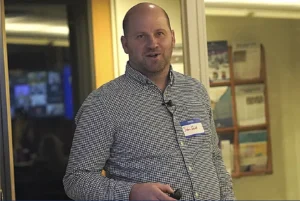
KCI Moderator Justin Sewell Director of Programs & Partnership
&auot;Especially in this moment of learning recovery, where we are working hard to enable students who experienced the effects of the pandemic to recover, to accelerate in their learning, and of course, that is a critical time to value the support and retain teachers who are experts in doing that work. So it is a very important time to recognize that we have teacher shortages around the country. We need to be addressing them very intently.&auot;
What is the strongest predictor of student success?
&auot;As you undoubtedly know, the single, most powerful predictor of student achievement is the presence of well-qualified and experienced teachers, especially true for students of color. We did a study in California at the Learning Policy Institute of positive outlier school districts – those that succeed beyond others in raising achievement for black, Latin, and white students from across household income levels, and we found that the strongest predictor of student success was the level of teacher qualifications and experience that replicates many other studies that have been done across the country, and the strongest predictor of low achievement was the number of teachers on emergency permits and substandard credentials.
Yet, we are not trying to activate the most skillful teaching possible to support learning, acceleration, and recovery; we have thousands of teachers entering without preparation for teaching – to fill nationally more than 200,000 classrooms without qualified teachers due to shortages.”
…We have thousands of teachers entering without preparation for teaching – to fill nationally more than 200,000 classrooms without qualified teachers due to shortages.
Dr. Linda Darling-Hammond
Why do many teachers not stay in the profession?

Gay Krause Executive Director, KCI
“It’s very hard to enter (into) teaching. Try to prepare to teach in the evening and on weekends. Twice as many teachers leave in the first year as teachers who come comprehensively prepared. This leads to churn in schools hiring many such teachers, which depresses achievements and further exacerbates the shortages.
We often think of shortages as being about teacher recruitment, but teacher retention is even more important. About 9 out of 10 vacancies we have to fill each year are to replace teachers who left the year before. Most of them leave for reasons other than retirement (two-thirds). Usually, there are elements of dissatisfaction with the context of teaching associated with that. So, this is a very crucial moment.
Since the pandemic (an) alarmingly high number of teachers have been signaling their intentions to leave.”
Last year a survey reported:
- 90% of teachers felt they experienced burn-out
- 74% had to fill in for colleagues or take on other duties because of staff shortages
- 55%+ plan to leave education sooner than originally planned (this is even higher among black, Latino/Latina teachers)
“As you know, there are many issues to address that are having a huge burden on teachers. There has also been a (lot) happening in the national context, where we’ve seen a decrease in people coming into teacher education. This is not just a pandemic problem. For more than 20 years, teacher attrition has been high, about 8%, in the United States. As compared to 3-4% in countries like Canada, Singapore, or Finland, where it really is a career of choice.”
Teaching conditions in the U.S. compare poorly with those of other industrialized countries. When you look at what tops surveys of why teachers are leaving (you will find) teaching conditions (at the top).
Dr. Linda Darling-Hammond
So why do we have such attrition in the United States?
“Teaching conditions in the U.S. compare poorly with those of other industrialized countries. In 2021, U.S. teacher salaries were more than 20% lower than those of other college graduates. In California, we are doing a bit better (with) a 15% differential between teachers and other graduates. But, as you well know, the cost of living is very high (along with) housing costs. So that disparity in working conditions and living conditions (is) certainly part of our reality
We find that in high-performing counties like Finland, Estonia, and Germany, some of those at the very top comparison is really quite equitable. We had the closest competitiveness between teachers and other professions in the early nineties. Teachers’ wages have been more or less frozen once you account for inflation.
When you look at what tops most surveys of why teachers are leaving (you will find) teaching conditions, which include the hours. Teachers go into the profession not because they expect to earn a lot of money but because they want to do good work for children, and having a context in which they can be effective is the most important thing for retaining teachers.
One of the things we have seen in international surveys is that teachers in the U.S. teach more hours per week and year than teachers in any other country in the world, except for Chile, which is tied with the U.S. This is about eight hours more, on average, for the American teacher (per week). This means there is much less time during the work day for collaboration and planning opportunities or to pick up the phone and call a parent and grade. A lot of that work spills over in the hours after the work day. (This) also accounts for the number that U.S. teachers work, which is about fifty-five hours.
Now some schools have redesigned and begun to change that. But this is a routine experience for teachers in the U.S. This is just one of the things we need to be cognizant of and begin to change the context for teaching.”
Other areas teachers gave for leaving:
- Test-based accountability practices
- A lack of influence over school policies and practices
- A lack of autonomy in the classroom to make decisions
- Inadequate opportunities to collaborate with colleagues
- Inadequate opportunities for leadership or professional advancement
“Teachers are much more likely to stay in collegial environments where they can plan and work with colleagues to problem-solve. That’s a really important variable. These are the symptoms in the U.S. of deep professionalized occupation, which is very different (elsewhere).”
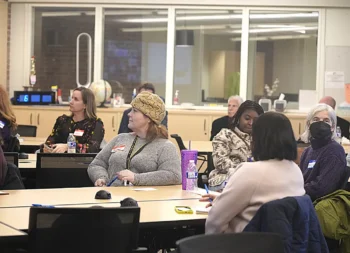
Workshop Participants
Teachers are more likely to stay in collegial environments where they have the opportunity to plan and work with colleagues to problem solve.
Dr. Linda Darling-Hammond
What is the solution?

“The answer to shortages is not to reduce the standards. It is really to improve the incentives for teaching…”
“So the answer to shortages is not to reduce the standards. It is really to improve the incentives for teaching. All of this takes time. If you were going to teach in Finland or Singapore, small countries that are about the size of our median states in the U.S., you would get a free ride – you would, first of all, come into the profession (with) very high-quality preparation and no tuition to pay with a stipend or salary. While you’re training, you go into a school where there are senior mentor teachers made available for mentoring beginning teachers and supporting
ongoing professional development. You would also have additional time in the work day and week to collaborate regularly with others. You’d be paid equivalently to other professionals and receive a lot of respect and high status in society. By just ticking off those things, you can see the differentials and why it is more difficult to retain teachers.
We see that the positive, outlier districts have had high teacher retention because they put in place the learning conditions and the teaching conditions along with the compensation that make it possible for people to have a positive experience.”
Possible Teacher Incentives Could Include:
- Creating affordable, accessible pathways into the profession.
- Creating residency programs aimed at solving teacher shortages and making it possible to have high retention rates.
- Establishing partnerships with universities and other entities to provide training. Providing mentors to the newest teachers with stipends for the mentors.
- Determine what incentives will support teachers in a particular community. Funding opportunities for National Board-certified teachers.
- Providing literacy coaches and specialists with stipends.
- Helping those who need it most with mentors and training.
- Offering recruitment incentives across the board for needed support.
- Creating school conditions in which people can be effective.
- Moving beyond the factory model we inherited a hundred years ago to much more personalized and relational settings.
- Organizing, resident advisory programs that allow teachers to have the capacity to follow up on their students.
- Offering more supportive and effective environments for teachers and students. Rethinking the school schedule to accommodate these actions.
“As you know, all of this is essential for learning recovery. We have an opportunity right now to seize this movement and double down on creating a stronger teaching profession in organized schools to support their success. We all know that teaching is a profession that all other professions depend on. Our society needs great teachers to nurture great learners, people who are empowered to be curious, to imagine, and to tackle the enormous problems we face today and those we can’t yet foresee. These investments we are making in teachers need to be made (as) our investments in our children and our collective future.”
We all know that teaching is a profession that all other professions depend on. Our society needs great teachers to nurture great learners.
Dr. Linda Darling-Hammond
Workshop Panelists
We invited our panelists to answer questions and share experiences about teacher retention challenges and solutions from their points of view. The following provides a brief overview of some of the discussions. Please see our recording for the full conversation!
Melanie Leung-Gagné Researcher & Policy Associate, Learning Policy Institute
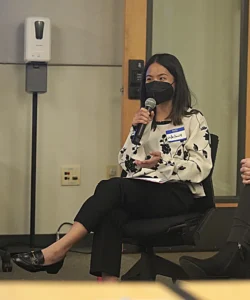
Melanie Leung-Gagné
Melanie is a researcher and policy associate at the Learning Policy Institute. Her primary focus is on educator quality, and she works on issues regarding teacher shortages as well as teacher diversity.
How has teacher retention changed?
“So most of that is because of teachers leaving, and most is not because of resignations. Retention is very important, of course, in addition to recruitment, but retention is also important for several other reasons. First is cost, which is very expensive and time- consuming to hire, recruit, and onboard a teacher.
Research has found that, on average, it’s about $9,000 for an urban district to go up to $20,000 to onboard teachers. nationally each year, we spend 8 billion dollars hiring and onboarding teachers. This cost is, is big. If we can better retain our teachers, we can also save a lot of money and effort, so that’s one piece (as to) why retention is particularly important.
The second is student outcomes. As you all know, when a teacher can stay in a school for a long period, they can gain experience, and it’s sometimes it’s often specific to a school site specific to the students. They get to know their students better, know better how they learn, and be able to build closer relationships with them. All this is very conducive to building a positive school climate, one and many student outcomes, including student achievement.
The third piece is the equity aspect of it. Because students of color and students from low- income backgrounds are (often) those that bear the brunt of teacher shortages, this is a significant equity issue as well. Linda also mentioned the importance of high-quality preparation. How a teacher coming in who is comprehensively prepared is twice as likely to stay in the profession. When we’re talking about teacher shortages, sometimes we think about them as vacancies; it is essential to consider whom we are filling these positions with and how prepared they are.
We can think of it both from the supply and demand sides. The whole story is that shortages have been persistent, and Covid has made them more severe. On the other hand, we also see increasing demand, and we’re (seeing) this because of high attrition rates. We’re seeing more open positions but fewer qualified candidates to fill them. So it’s a double whammy. One of the districts we interviewed for one of our studies back in 2021; was starting their school year and typically hired 140 staff each year. At the beginning of the 2021-22 year, they hired 375, so that’s 2.5 times the staff they were still trying to hire.”
Sarah Williams, MTSS TOSA Union School District
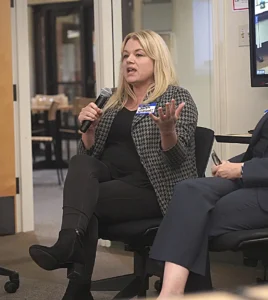
Sarah Williams
Sarah is a teacher on special assignment and is also an induction mentor for first and second- year teachers going through the process. She collaborates with Santa Clara County and Santa Cruz County.
Please talk about your experience with the teacher induction program.
“The teachers that we’re working with are passionate. They’re there for the right reasons.
Not for the summer off or the big paycheck, but they’re there because they want to make a difference. They’re there for the kids, so they’re ready to collaborate. They’re also prepared to do the work. They’re ready for feedback, which is so important, and self-reflective. There’s a lot of goodness there. But another thing that we hear (as) we collaborate across the counties is that there are many tears, and I was really surprised. This is my first year as an induction mentor, and is it just something we see within our team? But no, it is across the board.
They’re feeling overwhelmed, and they’re sometimes feeling unsupported, and that could be due to their onboarding process. Maybe they never quite got that support, even with us mentoring them at their site or district levels. They’re not getting the support they need.
I wanted to bring specific examples, actual things, and scenarios that happened, and the first one is that we have new teachers who talk to veteran teachers who say, “you made the biggest mistake becoming a teacher; you should run now.” That happened this year. Here you are, ready to go, bride-eyed, bushy-tailed, and facing veteran teachers unwilling to support new teachers. So you’re being told that you have made a really bad decision in your life, and you’re so excited to go and hear this. How can we shift that climate within a school?
How can we get those teachers or our veteran teachers in the mid part of their careers (to support new teachers)? How can we fold them back in? I think co-teaching and collaborative teaching (should be considered), not only for the newest teachers but for those teachers in the middle of their careers and for our veteran teachers.
I do believe that when you have that community, you build that community, and people want to stay because they’re in it; they’re part of it. They feel respected. They feel heard, they feel a part of something, and it also allows for that collaboration to support one another, and not everything’s just on you.”
José Manzo, Superintendent Oak Grove School District
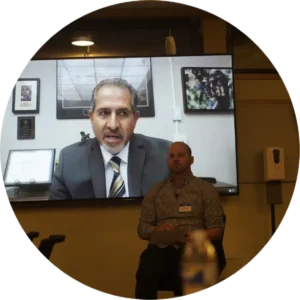
Jose Manzo
José is the superintendent of the Oak Grove School District in South San Jose and is in his eleventh year. Prior to that, he was the superintendent of Allen Rock School District, and before that was the Director of Elementary Education.
What are some of the new investments, residency programs & teacher grants you see that make a difference?
“We participate in 2 Residency programs with San Francisco State, one for special LED focus, and then also for regular LED. These residents are with us for an entire year.
They’re with a master teacher for an entire year. There’s somebody assigned to them to support them, and then they’re also part of the induction once they become a teacher as well.
We see that those teachers are very well prepared, and they have a sense of confidence and competence. I think that is very different from somebody that has had an 8-week experience in the classroom doing the work and teaching with feedback. They’re also part of all our professional development during that school year. So we’re seeing a lot of success in our Residency program participants and our student teachers.
We (give them) the ability to really build professionally with all the tools in their tool belt. (We want them) to be effective and feel that level of confidence is so important (combined) with the right level of competence. (Teachers) have so many plates to juggle, particularly with the social-emotional. I think opportunities to be immersed in experiences and to have the resources (available) are really important.”
Dr. Nellie Meyer, Superintendent Mountain View School District

Dr. Nellie Meyer
Nellie is the Moutain View School District superintendent and is in her fourth year there. Before that, she was deputy superintendent at San Diego Unified.
What are some of the ways we can negotiate contracts, so there is time for educators to learn and grow?
“Time is one thing, and it’s very important. Our district is very fortunate in that area. But time is something everyone would have to have an equivalent amount of.
So I was hesitant. One of the biggest things I wanted was to allow us to have a waiver for some of the requirements we have around time. It’s not, as you know, as a superintendent, I don’t really want to say, “everyone teach less.” When you look at the universities, and you look at what they are doing, they have a model where students are in class for a certain amount of time, and then professionalism is expected by the student and staff to address the needs.
I would like to see California move away from this idea of seat time and be really flexible. We need to be flexible and (consider) what we could do differently to address the needs of our students. How can we build our days differently, and what do we have to do to have that flexibility?
It is very difficult with a K-12 system to give the students the standards and meet their needs. The requirements we have as a state and nation confine us. We need to look at our European and Canadian models to see how we can build collaborative time for teachers within a day. We can. It has to be agreed upon.
We can also limit the work teachers are doing at night because it leads to burnout. And we are driving people away from the profession. One last thing, I had hoped that the pandemic would allow us to fly and be a little freer when we returned. It is amazing how quickly we snapped right back. It is sad.
We have the funding, we have the will, and we have the urgency around our students’ learning needs and our staffing needs. So the flexibility of some of these mandates and requirements that have been around for twenty years (needs to change). Let’s look at how we can apply for waivers and how we can improve.”

